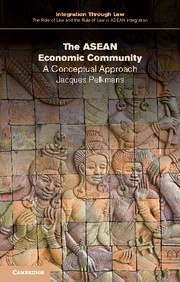Book contents
- Frontmatter
- Contents
- List of figures
- List of tables
- List of boxes
- General editors’ preface
- 1 Introduction and purpose
- 2 Foundations of economic integration fundamentals, stages and credibility
- 3 Conceptual foundation of the ASEAN Economic Community
- 4 Implementation of the AEC: progress in adopting instruments from the Roadmap
- 5 A reality check: comparing the AEC and NAFTA on substance
- 6 Options for the AEC and their practical implications
- 7 Conclusions
- Executive summary
- Appendix 1
- References
- Index
4 - Implementation of the AEC: progress in adopting instruments from the Roadmap
Published online by Cambridge University Press: 05 March 2016
- Frontmatter
- Contents
- List of figures
- List of tables
- List of boxes
- General editors’ preface
- 1 Introduction and purpose
- 2 Foundations of economic integration fundamentals, stages and credibility
- 3 Conceptual foundation of the ASEAN Economic Community
- 4 Implementation of the AEC: progress in adopting instruments from the Roadmap
- 5 A reality check: comparing the AEC and NAFTA on substance
- 6 Options for the AEC and their practical implications
- 7 Conclusions
- Executive summary
- Appendix 1
- References
- Index
Summary
Adopting and elaborating instruments from the Roadmap is a major technical implementation exercise, indispensable for the emergence of a workable AEC. The following will offer a detailed scrutiny of the implementation of three of the five ‘instrumental objectives’: free flows, the single ASEAN market and ASEAN as a production base. Progress is incorporated up to the spring of 2013.
Implementing the free flows
The Roadmap clarifies the ambitions of the ‘free flows’ to be accomplished for goods, services, investment and skilled labour.
Implementing the free flow of goods and ATIGA
With respect to goods, the Roadmap goes far beyond what one might expect from AFTA. A fifteen-item customs modernisation and cooperation programme (including cargo processing and a transit system) and a range of trade facilitation measures demonstrate this ambition. The complex patchwork of AFTA/CEPT measures has been integrated into ATIGA. ATIGA is surely an improvement in substance and it is convenient and more transparent than the AFTA patchwork for business and others. Tariffs inside ASEAN are hardly the problem anymore, and MFN tariffs have come down as well during the construction of AFTA. Moreover, applied tariffs are usually lower still. We are only unclear about export taxes (assuming that they are not seen as NTMs), of importance given the recent extensions of such taxes on, for example, minerals by Malaysia and Indonesia.
The problem is another one. Article 1 of ATIGA sets the bar very high in stating that the ‘objective of this Agreement is to achieve free flow of goods in ASEAN … by 2015.’ On this account, one can criticise ATIGA because neither the full obligations are guaranteed for that purpose nor the institutional conditions would seem to be fulfilled. Some of the lingering problems of ATIGA are explained in Box 4.1, based on an elaborate and careful legal and institutional analysis by Inama and Sim (2013a) from which we quote or paraphrase freely. We have chosen to emphasise these shortcomings in a separate box for the obvious reason that ATIGA's ambition is critical to the performance of ASEAN segments of global value chains, quite apart from ‘free flow’ being the core of a single market. In the final analysis, whatever the services and skill input in value-added in global value chains, what is decisive for business is to easily, if not freely, move goods in and out of countries in the region.
- Type
- Chapter
- Information
- The ASEAN Economic CommunityA Conceptual Approach, pp. 116 - 166Publisher: Cambridge University PressPrint publication year: 2016



